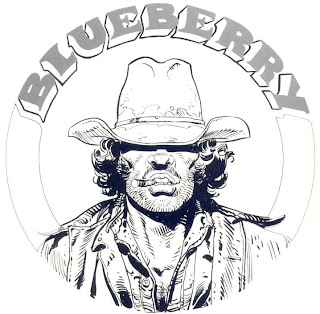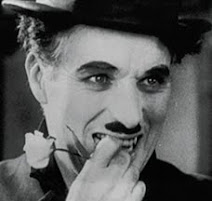Le Bal (Limited Edition Serigraph print, 2002)
Giraud began his career in the 1950's, where he created, together with writer Jean-Michele Charlier, a daily strip and eventually full-fledged comics about Lieutenant Blueberry, a U.S. cavalry officer; Alan Delon meets the Old West. Occasionally, he would illustrate other Western tales Charlier developed outside the Blueberry story line -- which Giraud would sign "Gir".
Original first page of "Missip[p]i River", 1967;
Giraud's artistic style echoed pen and brushwork of American and
British comics in the mid-1960's (Click on image to enlarge. Easy! Fun!)
In America, the artistic style of mainstream comic illustration was bounded by DC Comics (Superman, Batman, Justice League) or the more recent Marvel Superheroes, and alternative-but-still-mainstream publications like MAD Magazine -- specifically the pen-and-ink artist Mort Drucker. Comics in the UK likewise had developed a distinctive style that borrowed from DC or Marvel, but also rooted in British-only comics like Bingo.
Comparison of styles between American Mort Drucker (left)
and Giraud's work in the mid-1980's on Blueberry (right).
Drucker used a nib pen, and was more inclined to caricature;
Giraud was a realist who favored brushes and Rapidograph technical pens.
In the Counterculture of the middle Sixties to the mid-70's, America's 'Underground' comics developed their own artistic styles far removed from those of DC or Marvel. They were a Fuck You delivered to America's Puritan cultural traditions around sexuality and materialism, first, and only secondarily an attempt to push the boundaries of illustration. It would take the development of graphic novels, and the work of American artists like Chris Ware, Lynda Barry, Charles Burns, the Brothers Hernandez and Art Spiegelman to change that.
Meanwhile, in Europe, artists like Giraud saw their medium as dominated by America's "Superhero" format, and hidebound with traditions established before the First World War. More than in America's underground comics, European illustrators were producing images influenced by the 'psychedelic revolution' -- expanding personal consciousness to touch the Universal; having experiences which provided glimpses of 'other', alternate realities.
Jimmy Hendrix's Psychedelic Lunch (Virtual Meltdown, 1976)
The most accessible, commercial version of these visions was exemplified by Peter Max -- his colorful deconstructions of reality were simple, beautiful; but not too complex or ambiguous for the viewer. It didn't really challenge their preconceptions of reality, just enhanced them in a non-threatening, cartoon manner -- as in Yellow Submarine.
In 1974, Giraud joined two other French artists -- Phillipe Drullet and Jean-Pierre Dionnet -- and a businessman, Bernard Farkas, forming Les Humanoïdes Associés (The United Humanoids), to publish a quarterly magazine of cutting-edge 'adult' illustration, Metal Hurlant (literally, "Screaming Metal").
Metal Hurlant, Issue No. 1, December 1974 (Wikipedia Commons).
The first issue was released in December, 1974, and included work not just by Giraud and Drullet but included work by American Richard Corben. Later issues would feature another American cartoonist, Vaughn Bodé (creator of Cheech Wizard, and Junkwaffel), along with Brazilian Sergio Macedo, Swiss artist Daniel Ceppi, and the Dutch illustrator Joost Swarte,whose work carries on the traditions of the bandes dessinées and 20th-century Dutch design (Swarte's work appears heavily influenced by Herge's TinTin).
Not in Mort Drucker's style: Before the first Star Wars,
Giraud was creating pen-and-ink aliens in France's Metal Hurlant.
This 1975 illustration, 'The Usual Suspects', shows some Moebius standards --
Arzach [center, back row], Major Grubert [second row left, in spiked helmet],
and Malvina [second row, far right, with rifle] of The Airtight Garage;
and Giraud [front row, right], with glasses (Click on image -- yes; for the Fun).
Metal Hurlant published stories with science fiction or fantasy themes -- the most natural channels for this new imagery. But Giraud's work was so singular and unique that it took the reader / viewer into places where space, time, and scenery twined around each other: Part Oz, part Yaqui Way Of Knowledge, and part comic strip.
Giraud's major illustrated works include Arzach, the adventures of a humanoid with a tall hat, who rides the back of a creature like a prehistoric Pertodactyl through landscapes that resemble Bryce Canyon, or the mountains of Morocco. Like the rest of Giraud / Moebius' creations, there is spare dialog but no sound effects; Arzach's world is starkly beautiful, populated by strange beings and amazing beasts, but often silent.
First episode of Arzach; Metal Hurlant, 1975-76
(Click On Image to Bigger Buh Buh Buh Bleep.)
In the episodic "Airtight Garage of Jerry Cornelius", Giraud presents a world existing in different dimensions, like interlocking computer simulations, each of which can be accessed if you know the secret passages. Each lower level is unaware they are part of that chain, yet still affecting (and affected by) the others.
Major Grubert, guest of the Wascally Wabbits and their Big Crystal Skull.
(Clickety Click Click Click.)
Major Grubert, an agent for the first level, is trying to thwart a plot to unify all levels. A resident of a lower level, Jerry Cornelius, appears to be central to the plan; Grubert keeps looking for but never quite catches him, all the while threatened by conspiratorial forces, wacky rabbits, and The Bakelite.
Grubert survives an assassination attempt while meeting an agent
in a crowded 2nd level bar (The Airtight Garage, 1975)
The Incal was an episodic story written by Alejandro Jodorowsky, with a group of adventurers moving through an Oz-like universe, batted about over the fate of the Light Incal and Dark Incal, crystals of enormous power.
The Incal, volume 4
(Clicky-Clicky)
(Note: Moebius and Jodorowsky sued Luc Besson, director of The Fifth Element, claiming that the film used aspects of The Incal in the script without permission; they lost the suit.)
Giraud's last major works were Inside Moebius (titled in English for the French original), and 40 Days dans le desert B (Forty days in desert B). Inside was several volumes of autobiographical writing and illustration.
Moebius' perception of Disney's effect upon culture:
The Wrath Of The Mouse (Click To See Larger Horrible Mouse)
"Forty Days" depicted a number of Giraud's themes about the effect of our consciousness on the world around us. The meditating traveler in 40 Days certainly does that.
I began looking at Giraud / Moebius' work in 1975, when the company which published 'National Lampoon' began reprinting Metal Hurlant in the United States, with English translations, as Heavy Metal. I was stunned at how good, how imaginative it was -- incredible, rich, detailed and sure; there wasn't a sense of hesitation in a single line.
The worlds he created were complete -- from its architecture and equipment, to strange little creatures or background flora, down to the rubbish in the street. It was like looking at sketches, made while on vacation in another dimension, which Giraud had brought back to show us. And it wasn't a terrible or totally unfamiliar, nightmarish place. Even the incredible events he depicted seemed completely comprehensible, given where we were. They were places that vibrated with a sense of adventure and amazement.
And the best art does that -- surprise and amaze; show us something we only dimly and incompletely saw, like furniture in a dark room. That kind of art literally brings some new thing into the open, and changes how we perceive the world, and what's possible in it. Moebius' work did all of that.
The worlds he created were complete -- from its architecture and equipment, to strange little creatures or background flora, down to the rubbish in the street. It was like looking at sketches, made while on vacation in another dimension, which Giraud had brought back to show us. And it wasn't a terrible or totally unfamiliar, nightmarish place. Even the incredible events he depicted seemed completely comprehensible, given where we were. They were places that vibrated with a sense of adventure and amazement.
And the best art does that -- surprise and amaze; show us something we only dimly and incompletely saw, like furniture in a dark room. That kind of art literally brings some new thing into the open, and changes how we perceive the world, and what's possible in it. Moebius' work did all of that.
_____________________________________________________________________

















What a great summary of the amazing work of Jean Giraud aka Gir aka Moebius. Especially your last three paragraphs: I often felt what you spelled out - he created complete worlds with the simplest of lines, spare and beautiful, but full of details of everyday life in those realms - that's one reason they were recognizable, even though we knew they were not of this world, even when they were completely alien.
ReplyDeleteI first ran into Moebius' work in 1977 I think, when I discovered issue #2 of Heavy Metal, and after that I was hooked on anything Jean created. Then in the early '80s I saw a flyer on the floor of a comic store in Long Beach that advertised Starwatcher Graphics, headed by Jean's wife to promote and sell his work. I called them up and got to know them a bit - I helped them sell some of his graphic art (serigraphs mostly) in L.A., but not for money - he compensated me in art, so I've got several nice pieces from him, serigraphs and Aedena publications, etc., including an original collaboration between Moebius and Geof Darrow. Real treasures for me. Again, thanks for your writeup, you captured a lot in a short space. And as you say, his art opened up new dimensions that brought something new and different to light, something amazing, fantastic and delightful.